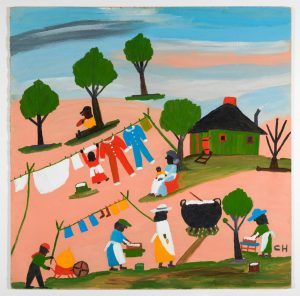Roger Catlin in Smithsonian:
 She was born just 20 years after the Civil War. Her grandparents were enslaved. And after decades of working in a storied Louisiana plantation, Clementine Hunter picked up a brush and began depicting African-American life in the South, turning out thousands of paintings first sold for less than a dollar that are now fetching thousands. Often called the black Grandma Moses, for the simplicity of her work and her late life enthusiasm for it, the artist, who died in 1988 at age 101, is being celebrated in an exhibition held in the Rhimes Family Foundation Visual Art Gallery at the Smithsonian’s National Museum of African American History and Culture in Washington, D.C.
She was born just 20 years after the Civil War. Her grandparents were enslaved. And after decades of working in a storied Louisiana plantation, Clementine Hunter picked up a brush and began depicting African-American life in the South, turning out thousands of paintings first sold for less than a dollar that are now fetching thousands. Often called the black Grandma Moses, for the simplicity of her work and her late life enthusiasm for it, the artist, who died in 1988 at age 101, is being celebrated in an exhibition held in the Rhimes Family Foundation Visual Art Gallery at the Smithsonian’s National Museum of African American History and Culture in Washington, D.C.
Hunter was born into a Creole family at the Hidden Hill Plantation, thought to be the inspiration of Uncle Tom’s Cabin. It was there, in the Cane River region of central Louisiana where she began working in the fields while young, receiving less than a year of formal education and never learning to read or to write. Her family moved to Melrose Plantation, south of Natchitoches, when she was 15, continuing to work picking cotton and harvesting pecans until the 1920s when she became a domestic worker, cooking and doing laundry. “Melrose Plantation was interesting because it was started by a mixed-race Creole,” Fleming says. By the time Hunter moved there, it was run by a woman who cultivated the arts, and “would have artists from all over the country come and live as artists in residence.” The writers and artists who spent time there in the out buildings she restored and brought in, ranged from William Faulkner and writer Lyle Saxon, to film star Margaret Sullavan, critic Alexander Woollcott and photographer Richard Avedon.
More here.
